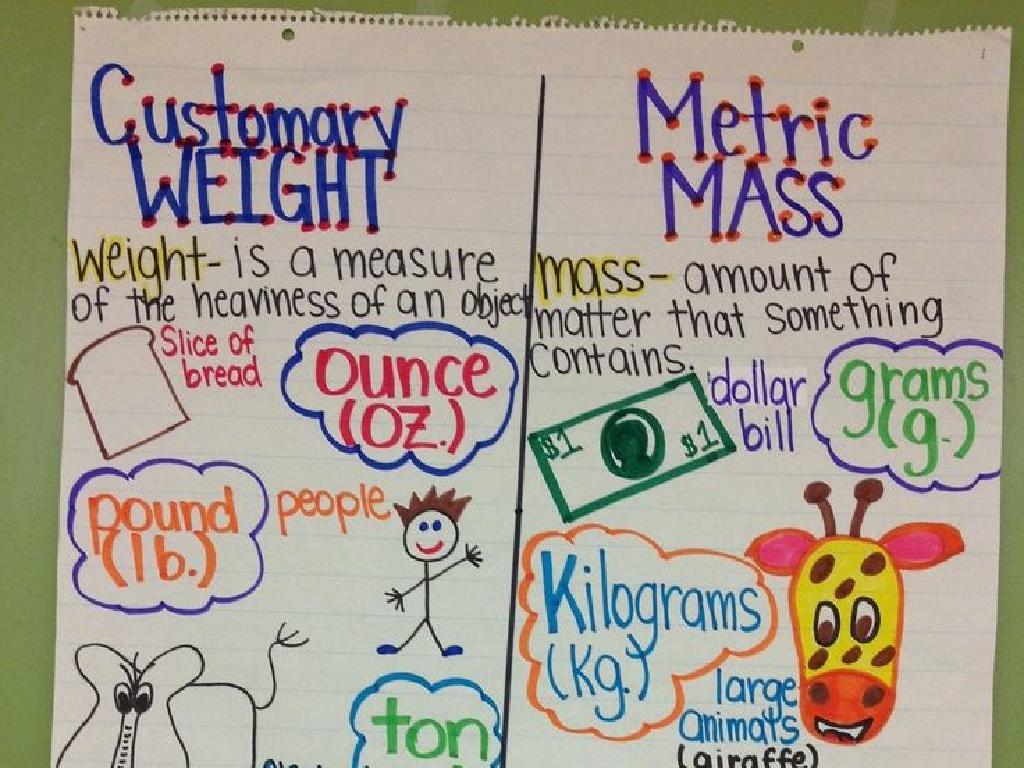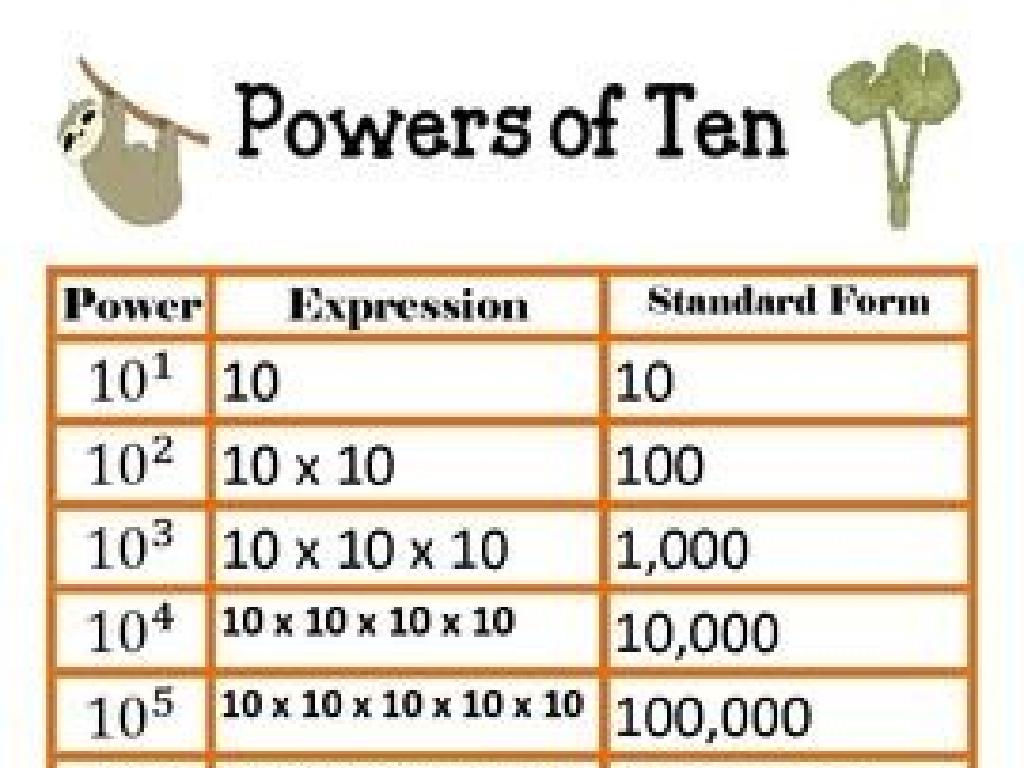Division Facts Up To 10: True Or False?
Subject: Math
Grade: Third grade
Topic: Division Fluency Up To 10
Please LOG IN to download the presentation. Access is available to registered users only.
View More Content
Welcome to Division: Mastering Facts up to 10!
– What is division?
– Division is splitting into equal parts or groups.
– Division as sharing equally
– Like sharing 10 cookies with 5 friends, how many does each get?
– Division facts up to 10
– True or False: 9 divided by 3 equals 3?
– Division’s role in math
– It helps us solve problems and understand numbers better.
|
This slide introduces third graders to the concept of division, emphasizing its importance and application in everyday math. Begin by explaining division as the process of splitting a number into equal parts, using relatable examples such as sharing items equally among friends. Highlight the significance of mastering division facts up to 10, and encourage students to think of division as a super skill that can help them in various math scenarios. Engage the class with true or false questions to assess their understanding of division facts. This interactive approach will help solidify their foundational division skills.
Understanding Division
– Division is sharing equally
– Imagine splitting snacks with friends so everyone gets the same amount.
– It shows groups or items per group
– How many ways can you split something? Or how many in each split?
– Example: 10 cookies shared by 2
– If you have 10 cookies and 2 friends, how do you share?
– Each friend gets 5 cookies!
– From the example, every friend gets an equal share of the total cookies.
|
This slide introduces the concept of division to third-grade students by relating it to a relatable scenario: sharing cookies with friends. It’s important to emphasize that division is about equal distribution, whether it’s determining the number of groups that can be formed or the number of items in each group. Use the example of sharing 10 cookies between 2 friends to illustrate this point, showing that each friend gets 5 cookies. Encourage students to think of division as a fair way to share and to come up with similar examples from their daily lives. This will help them understand the practical application of division and prepare them for learning division facts up to 10.
Mastering Division Facts Up to 10
– Memorization speeds up problem-solving
– Review division facts as a class
– For example, 9 divided by 3 equals 3
– Multiplication checks division accuracy
– If 3 times 3 equals 9, then 9 divided by 3 is 3
– Practice makes perfect
– Keep practicing with different numbers!
|
This slide aims to emphasize the importance of memorizing division facts to enhance speed and efficiency in problem-solving. Start by explaining how knowing division facts by heart can save time during tests or homework. Engage the class by reviewing some common division facts together, ensuring participation from all students. Highlight the use of multiplication as a method to verify the accuracy of division answers. For instance, if students know that 3 times 3 equals 9, they can confidently say that 9 divided by 3 equals 3. Encourage daily practice of these facts, perhaps through fun activities or games, to help students commit them to memory. The goal is for students to become fluent in division facts up to 10, making their future math challenges more manageable.
Division Facts: True or False?
– Is 9 divided by 3 equal to 3?
– True, because 3 groups of 3 make 9
– Does 10 divided by 5 equal 3?
– False, because 10 divided by 5 is 2
– Can 8 be divided equally by 2?
– True, 8 divided by 2 gives 4 equal parts
– Understanding division facts
|
This slide is designed to test students’ understanding of basic division facts. It’s a quick true or false activity where students can apply their knowledge of division to determine the accuracy of each statement. For each question, encourage students to visualize the division as groups of numbers or as repeated subtraction. Remind them that division is about making equal groups and that the result of division is called the quotient. After the activity, review the correct answers and explain why each statement is true or false. This will reinforce their division skills and prepare them for more complex problems.
Division Fluency Game: True or False?
– Get ready for a division game
– Listen to each division fact
– Use ‘True’ or ‘False’ cards
– If the fact is correct, show ‘True’. If not, show ‘False’
– Show your division superpowers
|
This interactive game is designed to help students practice and reinforce their understanding of division facts up to 10. As the teacher, you will state a division fact aloud, and students will respond by holding up ‘True’ or ‘False’ cards. For example, if you say ‘9 divided by 3 equals 3,’ students should hold up the ‘True’ card. If you say ‘8 divided by 2 equals 5,’ they should hold up the ‘False’ card. This activity encourages active participation and allows you to quickly assess students’ fluency with division facts. Prepare a list of division facts beforehand, ensuring a mix of true and false statements. Encourage students to answer quickly to promote fluency, and praise correct responses to boost confidence.
Division in Real Life
– Division used in daily activities
– Sharing equally among friends
– Like splitting a pizza into equal parts for each friend
– Dividing tasks fairly at home
– Assigning chores to each family member equally
– Splitting costs with family
– Figuring out how much each person pays for a meal
|
This slide aims to show students how division is a part of everyday life and not just a math concept. Provide relatable examples such as sharing snacks where division ensures everyone gets an equal amount, dividing chores among siblings to teach fairness, and splitting a bill to understand financial responsibility. Encourage students to think of other examples where they use division at home or in school. This will help them see the value of learning division facts and how it applies to real-world situations. During the presentation, ask students to share their own experiences with division to make the lesson interactive and engaging.
Class Activity: Division Bingo
– Receive your Division Bingo card
– Listen for true division facts
– Mark matching facts on your card
– Aim for five in a row to win
|
This interactive game is designed to help students practice and reinforce their understanding of division facts up to 10. Each student will receive a Bingo card filled with division facts. As the teacher calls out various division statements, students will need to determine if the statement is true and if it appears on their card. If it does, they mark it. The goal is to get five correct answers in a row, either horizontally, vertically, or diagonally. When a student achieves this, they shout ‘Bingo!’ The game provides a fun way to assess students’ fluency with division facts. Be prepared with a list of true and false division facts to call out. Have a few different Bingo cards to ensure a variety of winners. Encourage students to double-check their facts before shouting ‘Bingo!’ to practice accuracy as well as speed.
Wrapping Up: Division Facts Mastery
– Congratulations on learning division facts!
– Practice is key – continue at home
– Homework: Division Facts Worksheet
– Complete the worksheet to reinforce today’s lesson
– Be ready to discuss your answers
– We’ll review the worksheet together in our next class
|
This slide serves as a conclusion to the lesson on division facts up to 10. It’s important to praise the students for their hard work during the lesson and to emphasize the importance of continued practice at home to solidify their understanding. The homework assignment is the Division Facts Worksheet, which is designed to reinforce the concepts learned in class. Encourage students to try their best on the worksheet and remind them that we will go over the answers together in the next class, providing an opportunity for further learning and clarification. This will also help to assess their grasp of the material and identify any areas where they may need additional support.






